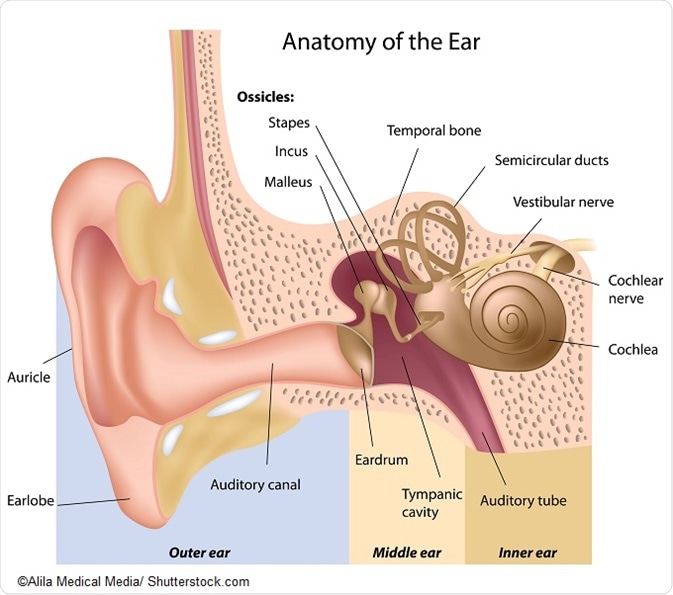The ear is the organ of hearing and balance. One of the very advanced sensitive organs of the human body, the ear detects, transmits, and transduces sound to the brain and maintains a sense of balance. Just as ripples are spread out in circles from the point where a stone is dropped in water, the sound source creates pressure variations in the air, which are perceived by the ear as sound.
Anatomy of the ear
The parts of the ear include the outer ear, the middle ear, and the inner ear.

The outer ear consists of the pinna or auricle, the part that we see on the side of the head, and the tube or external auditory canal that connects the outer ear to the middle ear through which sound travels.
The tympanic membrane or the eardrum lies between the outer and middle ear.
The middle ear is composed of ossicles and the eustachian tube. Ossicles consist of three small bones–malleus, incus, and stapes—that are coupled to transmit sound waves to the inner ear. The eustachian tube, lined with mucous, is a canal that helps to equalize pressure in the middle ear so that the sound waves are transferred properly. Sound enters the outer ear and makes the eardrums vibrate, and the vibrations are passed along the ossicles.
The inner ear consists of the cochlea, vestibule, and semicircular canals. The cochlea is the hearing part, comprising a coiled spiral tube containing nerves for hearing. The cochlea, a snail-shaped and fluid-filled structure, is in the inner ear. An elastic partition, which is the basilar membrane (serves as a base on which the important hearing structures resides), runs from the start to the end of the cochlea and splits it into an upper and a lower part.
Vestibule and semicircular canals are part of the balance system. The semicircular canals provide information to the brain about the direction of the head movement.
The process of hearing
Many stages are involved in the process of transduction i.e. the complex process by which sound waves are transformed into electrical signals, which are then conveyed by the auditory nerve to the brain.
How your ear works - Inside the Human Body: Building Your Brain - BBC
When we hear a sound, it is transmitted as a wave and reaches the outer ear. The sound waves pass through the ear canal, a slender passage, leading to the eardrum. When the eardrum is struck, the vibrations are sent to the ossicles in the middle ear. These small bones are responsible for amplifying the vibrations and sending them to the cochlea. A rippling effect is caused by the vibrations in the cochlea, and this results in the formation of a traveling wave along the basilar membrane. The sensory cells present on the top of the basilar membrane, called hair cells, recognize the sound waves.
Detection of a sound is dependent on its pitch - while high-pitched sounds are detected by the hair cells near the wide end of the cochlea, low-pitched sounds are identified by the hair cells closer to the center of the cochlea.
Stereocilia are vital for the process of electro-mechanical transduction. They are the microscopic hair-like projections that rest on and protrude from the top of the hair cells. These knock against a covering structure and are deflected when the hair cells move up and down. This process opens up the stretch-sensitive ion channels present at the tips of the stereocilia and allows the influx of specific cations, namely K+ and Ca2+, which generates an electrical signal. This signal travels through the auditory nerve to the brain, which is ultimately responsible for the processing of sounds, and recognition of inter-sound variability.
Pitch and intensity
It is important to understand the terms pitch and loudness, as together they are used to describe characteristics of a sound. The pitch, or sound frequency, is measured in hertz (Hz) and the loudness, or the intensity, of the sound is measured in decibels (dB).
Typically, the most important sounds that humans hear daily are in the range of 250–6,000 Hz where the normal ranges are 20-20,000 Hz. However, hearing becomes most sensitive in the 2000–5000 Hz frequency range.
The audible range for humans is 0-140 dB. While 0 decibels is the quietest, a whisper is around 25–30 dB and conversations are usually 45-60 dB, as speech is a combination of low- and high-frequency sounds.
Hearing & Balance: Crash Course Anatomy & Physiology #17
Hearing loss
If there are obstacles that stop the sound passing through the outer or inner ear, there could be conductive hearing loss. In sensorineural hearing loss, the problem could be with the inner ear or the hearing nerve. A combination of both may result in mixed hearing loss.
The sound information is passed from the ear to the brain via the auditory nerve, with the information processed by the auditory pathway as it travels along the auditory hearing system. This indicated the great role of brain pathways in the hearing process. Although sound can enter the ears, if there are damages to the inner ear or the auditory nerve, the brain cannot ‘understand’ the sound, resulting in Auditory Neuropathy Spectrum Disorder.
Exposure to more than 85 dB for long periods is dangerous to the hearing and may lead to temporary or permanent hearing loss.
Sources
- https://www.nidcd.nih.gov/health/how-do-we-hear
- https://www.cdc.gov/
Further Reading
Last Updated: Dec 29, 2022